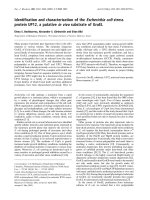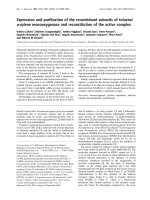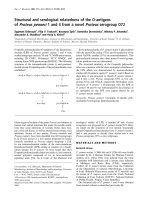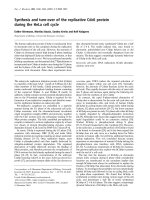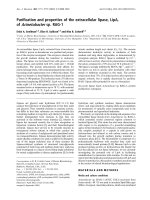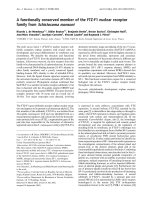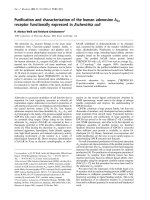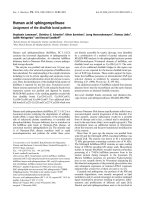Báo cáo y học: "Human embryonal epithelial cells of the developing small intestinal crypts can express the Hodgkin-cell associated antigen Ki-1 (CD30) in spontaneous abortions during the first trimester of gestation" ppsx
Bạn đang xem bản rút gọn của tài liệu. Xem và tải ngay bản đầy đủ của tài liệu tại đây (755.57 KB, 6 trang )
BioMed Central
Page 1 of 6
(page number not for citation purposes)
Theoretical Biology and Medical
Modelling
Open Access
Research
Human embryonal epithelial cells of the developing small intestinal
crypts can express the Hodgkin-cell associated antigen Ki-1 (CD30)
in spontaneous abortions during the first trimester of gestation
Demetrio Tamiolakis
1
, John Venizelos
2
, Maria Lambropoulou
3
,
Silva Nikolaidou
1
, Sophia Bolioti
1
, Maria Tsiapali
1
, Dionysios Verettas
3
,
Panagiotis Tsikouras
4
, Athanasios Chatzimichail
3
and
Nikolas Papadopoulos*
3
Address:
1
Department of Cytology, General Hospital of Chania, Crete, Greece,
2
Department of Pathology, Ippokration Hospital of Salonica,
Greece,
3
Department of Histology – Embryology, Democritus University of Thrace, Greece and
4
Department of Obstetrics and Gynecology,
Democritus University of Thrace, Greece
Email: Demetrio Tamiolakis - ; John Venizelos - ; Maria Lambropoulou - ;
Silva Nikolaidou - ; Sophia Bolioti - ; Maria Tsiapali - ;
; Panagiotis Tsikouras - ; Athanasios Chatzimichail - ;
Nikolas Papadopoulos* -
* Corresponding author
CD30 (Ki-1) antigenhuman intestinal cellsspontaneous abortionsvoluntary or therapeutic abortionsfirst trimester of gestation.
Abstract
Background: Ki-1 (CD30) antigen expression is not found on peripheral blood cells but its expression can be
induced in vitro on T and B lymphocytes by viruses and lectins. Expression of CD30 in normal tissues is very
limited, being restricted mainly to a subpopulation of large lymphoid cells; in particular, cells of the recently
described anaplastic large cell lymphoma (ALCL), the Reed-Sternberg (RS) cells of Hodgkin's lymphoma and
scattered large parafollicular cells in normal lymphoid tissues. More recent reports have described CD30
expression in non-hematopoietic and malignant cells such as cultured human macrophages, human decidual cells,
histiocytic neoplastic cells, mesothelioma cells, embryonal carcinoma and seminoma cells.
Results: We investigated the immunohistochemical expression of CD30 antigen in 15 paraffin-embedded tissue
samples representing small intestines from fetuses after spontaneous abortion in the 8th, 10th and 12th weeks
using the monoclonal antibody Ki-1. Hormones had been administered to all our pregnant women to support
gestation. In addition, a panel of monoclonal antibodies was used to identify leukocytes (CD45/LCA), B-
lymphocytes (CD20/L-26) and T-lymphocytes (CD3). Our findings were correlated with those obtained
simultaneously from intestinal tissue samples obtained from 15 fetuses after therapeutic or voluntary abortions.
Conclusions: The results showed that: (1) epithelial cells in the developing intestinal crypts express the CD30
(Ki-1) antigen; (2) CD30 expression in these epithelial cells is higher in cases of hormonal administration than in
normal gestation. In the former cases (hormonal support of gestation) a mild mononuclear intraepithelial infiltrate
composed of CD3 (T-marker)-positive cells accompanies the CD30-positive cells.
Published: 11 January 2005
Theoretical Biology and Medical Modelling 2005, 2:1 doi:10.1186/1742-4682-2-1
Received: 20 September 2004
Accepted: 11 January 2005
This article is available from: />© 2005 Tamiolakis et al; licensee BioMed Central Ltd.
This is an Open Access article distributed under the terms of the Creative Commons Attribution License ( />),
which permits unrestricted use, distribution, and reproduction in any medium, provided the original work is properly cited.
Theoretical Biology and Medical Modelling 2005, 2:1 />Page 2 of 6
(page number not for citation purposes)
Introduction
CD30 antigen, a member of the tumor necrosis factor
(TNF) receptor superfamily [1-3], was originally identi-
fied as a cell surface antigen on primary and cultured
Hodgkin's and Reed-Sternberg cells by use of the mono-
clonal antibody Ki-1 [4,5]. CD30 antigen is normally
expressed by a subset (15–20%) of CD3+ T cells after acti-
vation by various stimuli [6]. Its expression is stimulated
by interleukin (IL)-4 during lineage commitment of naïve
human T cells [7,8] and is augmented by the presence of
CD28 co-stimulatory signals [9]. CD30 also is expressed
at variable levels in different non-Hodgkin's lymphomas
(NHL) as well as in several virally transformed T and B cell
lines [5,10]. In particular, CD30 is a specific marker of a
subset of peripheral T cell NHLs known as anaplastic large
cell lymphomas (ALCL) [5]. More recently, preferential
CD30 expression has been detected on a subset of tissue
and circulating CD4+ and CD8+ T cells producing mainly
Th2 cytokines in immunoreactive conditions [11-14].
CD30 appears to have an important immunoregulatory
role in normal T cell development. Within the thymus,
CD30L is highly expressed on medullary thymic epithelial
cells and on Hassal's corpuscles [15].
Pallesen and Hamilton-Dutoir [16] were the first to report
CD30 expression outside lymphoid tissue in 12 out of 14
cases of primary or metastatic embryonal carcinoma (EC)
of the testis, using immunostaining with the monoclonal
antibodies (MAbs) Ber-H2 and Ki-1. Subsequently, sev-
eral investigators have confirmed their results and have
detected CD30 in these carcinomas at the protein [17-20]
and the mRNA [10] level. Two reports demonstrated
CD30 expression in 4/21 and 4/63 cases of testicular and
mediastinal seminoma [21] and in the seminomatous
components of 7/14 cases of mixed germ cell tumours of
the testis [22]. Suster et al. detected the CD30 antigen in
6/25 yolk sac tumours of the testis and mediastinum [22].
CD30 expression has also been reported in other non-
lymphoid tissues and cells such as soft tissue tumours
[23], decidual cells [24,25], lipoblasts [26], myoepithelial
cells [27], reactive and neoplastic vascular lesions [28],
mesotheliomas [29], cultivated macrophages, and two
histiocytic malignancies [30].
Primitive crypts (epithelial downgrowths into the mesen-
chyme between the small intestinal villi), appear in the
postpharyngeal foregut between the 9
th
and 12
th
weeks of
embryo development. Goblet cells are present in small
numbers after 8 weeks, Paneth cells differentiate at the
base of the crypts in weeks 11 and 12, and enteroendo-
crine cells appear between weeks 9 and 11.
The fact that the CD30 molecule can mediate signals for
cell proliferation or apoptosis [2] prompted us to perform
a systematic investigation of CD30 antigen expression in
non-hematopoietic embryonal tissues during the prolifer-
ation and differentiation stages, beginning with the epi-
thelial cells of the developing intestinal crypts.
Materials and methods
Samples representing 15 small intestines from fetuses
after spontaneous (involuntary) abortion occurring in
pregnant women treated with progesterone (300–600 mg
per day until the 12th gestational week), and 15 small
intestines from fetuses after therapeutic or voluntary abor-
tion, were obtained in the 8th, 10th and 12th weeks of
gestation. The Regional Ethics Committees approved the
study. Written informed consent was obtained from all
individuals and the procedures followed accorded with
institutional guidelines. Small intestines were cut in 3 mm
slices and fixed in 10% neutral buffered formaldehyde at
4°C for 24 h, then processed for routine paraffin embed-
ding. Paraffin blocks were available in all cases, and 3 µm
thick tissue sections were stained routinely with hematox-
ylin-eosin, PAS and Giemsa, and subsequently by immu-
nohistochemistry. Immunoperoxidase labeling was
performed as follows: sections were deparaffinized in
70% alcohol and endogenous peroxidase was blocked
with 3% H
2
O
2
in methanol. The sections were preincu-
bated in 20% serum of the species from which the second-
ary antibody was raised, and the primary antibody was
applied. After overnight incubation at room temperature,
the secondary biotinylated antibody was applied for 30
min. Staining was visualized with a Vector Elite System
(Vector Laboratories, Burlingame, CA) using diaminoben-
zidine as the chromogen. The sections were counter-
stained with dilute hematoxylin. The primary antibodies
used were as follows: (CD30/Ki-1) activated lymphoid
cells, mouse monoclonal antibody (Novocastra); (CD45/
LCA) leukocyte common antigen, mouse monoclonal
antibody (Dako); (CD20/L-26) B-lymphocytes, mouse
monoclonal antibody (Dako); and (CD3) T-lymphocytes,
mouse monoclonal antibody (Dako). We used the high
temperature antigen unmasking technique for immuno-
histochemical demonstration of CD30/Ki-1 on paraffin
sections (Novocastra). Control slides were incubated with
nonimmunized rabbit serum. An anaplastic lymphoma
case-slide (positive control) was run in parallel with the
assay.
Analysis of CD30/Ki-1 positive cryptae cells
For each sample, the CD30/Ki-1 positive population was
assessed by enumeration of labeled cells in each tissue
compartment for a minimum of five random fields per
section viewed at 40-fold magnification through a grid.
Cell numbers were calculated per mm
2
of tissue section.
The counted areas were selected from random tissue sec-
tions, taking into account that the ratio of the area of the
intestinal stroma to the area of surface epithelium
Theoretical Biology and Medical Modelling 2005, 2:1 />Page 3 of 6
(page number not for citation purposes)
covering the crypts was representative of the entire field.
Areas with obvious necrosis or haemorrhages were
excluded. Statistical analysis was performed using the
ANOVA test.
Results
Five microscopic fields of the small intestines were evalu-
ated in each case without knowledge of the clinical data
(TABLE 1). Two observers examined the sections inde-
pendently, and positive cellular staining for each antibody
was manifested as fine brown cytoplasmic granularity
and/or surface membrane expression.
8th week of gestation
In cases of spontaneous (involuntary) abortion, immuno-
histochemistry revealed small clusters or scattered, large-
sized CD30/Ki-1 positive cryptae cells within the intestine
in all settings examined (Fig. 1), with percentages varying
from 3.2 to 3.9 (mean ± sd = 3.61 ± 0.16). In the neigh-
bouring intestinal stroma a slight cellular infiltration was
observed, consisting of rounded mononuclear cells
approximately 10 µm in diameter with eccentric kidney-
shaped nuclei and expressing a CD45/LCA and CD3 phe-
notype. In cases of voluntary or therapeutic abortion,
immunohistochemistry showed a smaller number of
large-sized CD30/Ki-1 positive cryptae cells in all settings
examined (Fig. 2), with percentages varying from 3.1 to
3.7 (mean ± sd = 3.42 ± 0.17). No inflammatory infiltrates
or necrosis were noted in the neighbouring intestinal
stroma.
10th week of gestation
In cases of spontaneous abortion, immunohistochemistry
showed a higher number of positive CD30/Ki-1 cryptae
cells than at the 8th week of gestation (Fig. 3), with per-
centages varying from 4.9 to 5.6 (mean ± sd = 5.27 ±
0.19). There were very few inflammatory infiltrates in the
intestinal stroma expressing the phenotype CD45/LCA
and CD3. In cases of voluntary or therapeutic abortion,
the frequency of CD30/Ki-1 positive cryptae cells was sim-
ilar to that at the 8th week of gestation, with percentages
varying from 3.2 to 3.9 (mean ± sd = 3.43 ± 0.18). No
inflammatory infiltrates or necrosis were noted in the
neighbouring intestinal stroma.
Table 1: Expresion of CD30 antigen in fetal intestinal cryptae cells during the first trimester of gestation.
Spontaneous abortions Voluntary abortions
8th week 10th week statistics 8th week 10th week statistics
CD30(+)cells/mm
2
3.61+/0.16 5.27+/-0.19 p < 0.0001 3.42+/-0.17 3.43+/-0.18 p = 0.95
8th week 12th week statistics 8th week 12th week statistics
CD30(+)cells/mm
2
3.61+/-0.16 5.34+/-0.23 p < 0.0001 3.42+/-0.17 3.41+/-0.17 p = 0.95
8
th
week of gestation (involuntary abortions)Figure 1
8
th
week of gestation (involuntary abortions). Ki-1
(CD30) antigen is expressed by a small number of epithelial
cryptae cells. Immunohistochemical stain X 400.
8
th
week of gestation (voluntary abortions)Figure 2
8
th
week of gestation (voluntary abortions). Weak to
moderate expression of Ki-1 (CD30) antigen in the develop-
ing crypts. Immunohistochemical stain X 400.
Theoretical Biology and Medical Modelling 2005, 2:1 />Page 4 of 6
(page number not for citation purposes)
12th week of gestation
In spontaneous abortion cases the number of CD30/Ki-1
positive cryptae cells was even higher than at 10th week,
with percentages varying from 4.8 to 5.7 (mean ± sd =
5.34 ± 0.23). The number in cases of voluntary or thera-
peutic abortions was more or less the same as at 8th and
10th weeks, with percentages varying from 3.2 to 3.7
(mean ± sd = 3.41 ± 0.17). No differences in immune
reaction were noted in the neighbouring intestinal stroma
in cases of either spontaneous or voluntary/therapeutic
abortion in comparison to the 8th and 10th gestational
weeks.
The differences among the numbers of CD30/Ki-1 posi-
tive cells at the 8th, 10th and 12th gestational week after
spontaneous abortion were statistically significant (p <
0.0001). No significant differences were observed in the
numbers of these cells after voluntary or therapeutic abor-
tions (p = 0.95).
Discussion
The value of the CD30 antigen as a diagnostic marker for
Hodgkin's lymphoma and anaplastic large cell lymphoma
is well documented [4,5,31]. However, the function of
this cytokine receptor in Hodgkin's lymphoma and other
CD30-positive diseases is still not clear.
CD30 appears to have an important immunoregulatory
role in normal T cell development. In normal cells, this
transmembrane glycoprotein can be induced on B and T
lymphocytes by mitogen stimulation or viral transforma-
tion [32-34]. cDNA cloning has revealed that the CD30
protein is a cytokine receptor of the tumor necrosis factor
receptor superfamily [1,35], the ligand of which belongs
to the tumor necrosis factor family [22,23].
Recent in vitro data indicate that the CD30 receptor-lig-
and complex can mediate signals for cell proliferation,
apoptosis and cytotoxicity in lymphoid cells [20,36,37].
Our results give the first indication that the CD30 antigen
is expressed in the epithelial cells of developing intestinal
crypts. This observation has a number of important impli-
cations. First, our findings are of significance with regard
to the accepted origin of R-S cells. Care must be taken
when drawing histogenetic conclusions based on the
identification of a single marker in different cell types.
Shared expression of CD30 antigen does not necessarily
relate Hodgkin and R-S cells to activated lymphocytes.
The identification of this antigen in cells as apparently dis-
parate as activated lymphocytes, R-S cells and now human
epithelial cells of the developing fetal intestinal crypts
suggests that previous views about the nature of the Ki-1
antigen must be re-examined. The Hodgkin and Reed-
Sternberg cells are indeed lymphocytes as they harbor
rearranged immunoglobulin (in more than 90% of cases)
and T cell receptors [38]. Although the expression of
CD30 antigen may indicate a relationship between these
cell types, it is likely to be less straightforward than was
previously supposed. Identification of the normal
physiological role of CD30 antigen is thus made even
more imperative if these relationships are to be
understood.
Second, these findings indicate that outside the lymphatic
system, CD30 antigen expression in the epithelial cells of
developing intestinal crypts can mediate signals for cell
proliferation and differentiation in a region where other
cell types (stem, goblet, Paneth and enteroendocrine)
grow throughout life.
Third, CD30 expression in the epithelial cells of the devel-
oping intestinal crypts is induced by progesterone. This is
a novel mechanism of CD30 induction, distinct from neo-
plastic transformation and viral infection of lymphocytes.
The demonstration of large R-S like cells in the developing
crypts within a lymphoplasmacytic infiltrate, in the same
way that similar R-S like cells are observed in reactive
lymph nodes, especially within the parafollicular areas, is
evidence that such cells might represent the physiological
counterparts of R-S cells.
The possibility that CD30 is an oncofetal antigen is sup-
ported by our positive findings in fetal intestinal cryptae
cells. We have so far been able to investigate only a single
tissue from a small number of fetuses of early gestational
age. Pallesen and Hamilton-Dutoit [16] examined CD30
expression in normal adult, neonatal and fetal (week 28)
testes, as well as other tissues (brain, spinal cord, lung,
10
th
week of gestation (involuntary abortions)Figure 3
10
th
week of gestation (involuntary abortions). Strong
expression of Ki-1 (CD30) antigen in the developing crypts.
Immunohistochemical stain X 400
Theoretical Biology and Medical Modelling 2005, 2:1 />Page 5 of 6
(page number not for citation purposes)
gut, kidney, erythropoietic tissue, muscle, bone and con-
nective tissue) from fetuses of 11 and 12 weeks gestational
age, with negative results. This is the first demonstration
of CD30 in epithelial cells in fetal tissue. Although our
results require confirmation from frozen sections, they –
together with a reported positive staining in placenta
[24,25] – suggest that the antigen is expressed by prolifer-
ating and differentiating epithelial cells of other than lym-
phoid origin. Clearly the extent of expression of CD30
antigen in embryonal tissues warrants further
investigation.
References
1. Durkop ABC, Latza U, Hummel M, Eitelbach F, Seed B, Stein H:
Molecular cloning and expression of a new member of the
nerve growth factor receptor family that is characteristic for
Hodgkin's disease. Cell 1992, 68:421-427.
2. Smith CA, Gruss HJ, Davis T, Anderson D, Farrah T, Baker E, Suther-
land GR, Brannan CI, Copeland NG, Jenkins NA, Grabstein KH, Glin-
iak B, McAlister IB, Fanslow W, Alderson M, Falk B, Gimpel S, Gillis
S, Din WS, Goodwin RG, Armitage RJ: CD30 antigen, a marker
for Hodgkin's lymphoma, is a receptor whose ligand defines
an emerging family of cytokines with homology to TNF. Cell
1993, 73:1349-1360.
3. Smith CA, Farrah T, Goodwin RG: The TNF receptor super-
family of cellular and viral proteins: activation, costimula-
tion, and death. Cell 1994, 76:959-962.
4. Schwab U, Stein H, Gerdes J, Lemke H, Kirchner J, Schaadt M, Diehl
V: Production of a monoclonal antibody specific for Hodgkin
and Sternberg-Reed cells of Hodgkin's disease and a subset
of normal lymphoid cells. Nature 1982, 299:65-67.
5. Stein H, Mason DY, Gerdes J, O'Connor N, Wainscoat J, Pallesen G,
Gatter K, Falini B, Delsol G, Lemke H, Schwarting R, Lennert K: The
expression of the Hodgkin's disease-associated antigen Ki-1
in reactive and neoplastic lymphoid tissue: evidence that
Reed-Sternberg cells and histiocytic malignancies are
derived from activated lymphoid cells. Blood 1985, 66:848-858.
6. Ellis TN, Simms PE, Slivnick DJ, Jack H, Fisher RI: CD30 is a signal-
transducing molecule that defines a subset of human
CD45RO+ T-cells. J Immunol 1993, 151:2380-2389.
7. Nakamura T, Lee RK, Nam SY, Al-Ramadi BK, Koni PA, Bottomly K,
Podack ER, Flavell RA: Reciprocal regulation of CD30 expres-
sion on CD4+ T cells by IL-4 and IFN-γ. J Immunol 1997,
158:2090-2098.
8. Annunziato F, Manetti R, Cosmi L, Galli G, Heusser CH, Romagnani
S, Maggi E: Opposite role for interleukin-4 and inteferon-
gamma on CD30 and lymphocyte activation gene-3 (LAG-3)
expression by activated naïve T cells. Eur J Immunol 1997,
27:2239-2244.
9. Gilfillan MC, Noel PJ, Podack ER, Reiner SL, Thompson CB: Expres-
sion of the costimulatory receptor CD30 is regulated by both
CD28 and cytokines. J Immunol 1998, 160:2180-2187.
10. Gruss HJ, Dower SK: Tumor necrosis ligand superfamily:
involvement in the pathology of malignant lymphomas. Blood
1995, 85:3378-3404.
11. Del Prete G, De Carli M, Almerigogna F, Daniel CK, D' Elios MM,
Zanguoghi G, Vinante F, Pizzolo G, Romagnani S: Preferential
expression of CD30 by human CD4+ T cells producing Th2-
type cytokines. FASEB J 1995:81-86.
12. Manetti R, Annunziato F, Biagiotti R, Giudizi MG, Piccini MP, Gian-
narini L, Sampognaro S, Parronichi P, Vinante F, Pizzolo G, Maggi E,
Romagnani S: CD30 expression by CD8+ T cells producing
type 2 helper cytokines: Evidence for large numbers of CD8+
CD30+ T cell clones in human immunodeficiency virus
infection. J Exp Med 1994, 180:2407-2411.
13. Bengtsson A, Hohansson C, Linder MT, Hallden G, van der Ploeg I,
Scheynius A: Not only Th2 cells but also Th1 and Th0 cells
express CD30 after activation. J Leukoc Biol 1995, 58:683-689.
14. Hamann D, Hilkens CM, Grogan JL, Lens SM, Kapsenberg ML,
Yazdanbakhsh M, van Lier RA: CD30 expression does not dis-
criminate between human Th1- and Th2-type T cells. J
Immunol 1996, 156:1387-1391.
15. Romagnani P, Annuziatoa F, Manetti R, Mavilia C, Lasagni L, Manuelli
C, Vanelli V, Maggi E, Pupilli C, Romagnani S: High CD30 ligand
expression by epithelial cells and Hassal's corpuscles in the
medulla of the thymus. Blood 1998, 91:3323-3333.
16. Pallesen G, Hamilton-Dutoit SJ: Ki-1 (CD30) antigen is regularly
expressed by tumor cells of embryonal carcinoma. Am J Pathol
1988, 133:446-450.
17. Pallesen G: The diagnostic significance of the CD30 (Ki-1)
antigen. Histopathology 1990, 16:409-413.
18. Ferreiro JA: Ber-H2 expression in testicular germ cell tumors.
Hum Pathol 1994, 25:522-524.
19. De Peralta-Venturina MN, Ro JY, Ordonez NG, Ayala AG: Diffuse
embryoma of the testis, an immunohistological study of two
cases. Am J Clin Pathol 1994, 102:402-405.
20. Latza U, Foss HD, Durkop H, Eitelbach F, Dieckmann KP, Loy V,
Unger M, Pizzolo G, Stein H: CD30 antigen in embryonal carci-
noma and embryogenesis and release of the soluble
molecule. Am J Pathol 1995, 146:463-471.
21. Hittmair A, Rogatsch H, Hobisch A, Mikuz G, Feichtinger H: CD30
expression in seminoma. Hum Pathol 1996, 27:1166-1171.
22. Suster S, Moran CA, Domoguez-Malagon H, Quevedo-Blanco P:
Germ cell tumors of the mediastinum and testis: a compar-
ative immunohistochemical study of 120 cases. Hum Pathol
1998, 29:737-742.
23. Mechtesheimer G, Moller P: Expression of Ki-1 antigen (CD30)
in mesenchymal tumors. Cancer 1990, 66:1732-1737.
24. Ito K, Watanabe T, Horie R, Shiota M, Kawamura S, Mori S: High
expression of the CD30 molecule in human decidual cells. Am
J Pathol 1994, 145:276-280.
25. Papadopoulos N, Galagios G, Anastasiadis P, Kotini A, Stellos K, Pet-
rakis G, Zografou G, Polihronidis A, Tamiolakis D: Human decidual
cells can express the Hodgkin's cell-associated antigen Ki-1
(CD 30) in spontaneous abortions during the first trimester
of gestation. Clin Exp Obstet Gynecol 2001, 28:225-228.
26. Sohail D, Simpson RH: Ber-H2 staining of lipoblasts. Histopathol-
ogy 1991, 18:191.
27. Mechtesheimer G, Kruger KH, Born IA, Moller P: Antigenic profile
of mammary fibroadenoma and cystosarcoma phyllodes. A
study using antibodies to estrogen- and progesterone recep-
tors and to a panel of cell surface molecules. Pathol Res Pract
1990, 186:427-438.
28. Rudolph P, Lappe T, Schmidt D: Expression of CD30 and nerve
growth factor-receptor in neoplastic and reactive vascular
lesions: an immunohistochemical study. Histopathology 1993,
23:173-178.
29. Garcia-Prats MD, Ballestin C, Sotelo T, Lopez-Encuentra A, Mayor-
domo JI: A comparative evaluation of immunohostochemical
markers for the differential diagnosis of malignant pleural
tumours. Histopathology 1998, 32:462-472.
30. Anderssen R, Brugger W, Lohr GW, Bross KJ: Human macro-
phages can express the Hodgkin's cell-associated antigen Ki-
1 (CD30). Am J Pathol 1989, 134:187-192.
31. Schwarting R, Gerdes J, Dürkop H, Falini B, Pireli S, Stein H: Ber-H2,
a new anti-Ki-1 (CD30) monoclonal antibody directed at a
formol-recistant epitope. Blood 1989, 74:1678-1689.
32. Stein H, Gerdes J, Schwab U, Lemke H, Mason DY, Ziegler A, Schienle
W, Diehl V: Intentification of Hodgkin and Sternberg-Reed
cells as a unique cell type derived from a newly-detected
small cell population. Int J Cancer 1982, 30:445-449.
33. Froese P, Lemke H, Gerdes J, Havensteen B, Schwarting R, Hansen H,
Stein H: Biochemical characterization and biosynthesis of the
Ki-1 antigen in Hodgkin-derived and virus-transformed
human B and T lymphoid cell lines. J Immunol 1987,
139:2081-2087.
34. Andreesen R, Osterholz J, Lohr GW, Bross KJ: A Hodgkin cell-spe-
cific antigen is expressed on a subset of auto- and alloacti-
vated T (helper) lymphoblasts. Blood 1984, 63:1299-1302.
35. Mallet S, Barclay AN: A new superfamily of cell surface proteins
related to the nerve growth factor receptor. Immunol Today
1991, 12:220-223.
36. Beutler B, van Huffel C: Ultraveling fuction in the TNF ligand
and receptor families. Science 1994, 264:667-668.
Publish with BioMed Central and every
scientist can read your work free of charge
"BioMed Central will be the most significant development for
disseminating the results of biomedical research in our lifetime."
Sir Paul Nurse, Cancer Research UK
Your research papers will be:
available free of charge to the entire biomedical community
peer reviewed and published immediately upon acceptance
cited in PubMed and archived on PubMed Central
yours — you keep the copyright
Submit your manuscript here:
/>BioMedcentral
Theoretical Biology and Medical Modelling 2005, 2:1 />Page 6 of 6
(page number not for citation purposes)
37. Bowen MA, Olsen KJ, Lirong Cheng, Avila D, Rodack ER: Fuctional
effects of CD30 on a large granular lymphoma cell line. YT. J
Immunol 1993, 151:5896-5906.
38. Kadin M: Regulation of CD30 antigen expression and its
potential significance for human disease. Am J Pathol 2000,
156(5):1479-1484.

